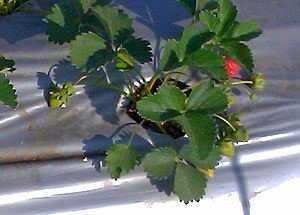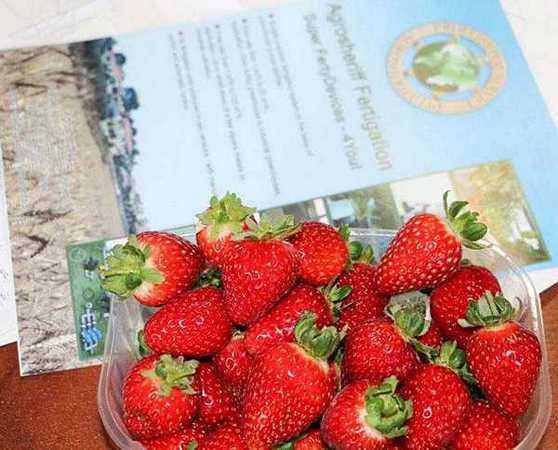Problems with the Strawberry harvest

A few tips for beginners. Experienced manufacturers hope these simple tips will be useful too.
Wild strawberries plant difficult. It is very demanding to external conditions to the soil or substrate, temperature, light, diet.
Often complain that strawberry plants at first glance look great, have a powerful machine sheet, large bushes, but why there is no harvest, or it is very small, despite the good care of the plants, great care and weight attached to the cultivation time and effort. Distressing outcome - no harvest, not berries.
But as we all know, nothing happens by accident. Necessarily have to be a reason.
We present here the main reasons for 9 in which your plants do not produce berries. It is likely that the situation prevailing in your area will be caused by one of these reasons ...
9 reasons for the problems with the harvest of strawberries :
1. Plants are too young
In the first year after planting strawberry plants will often produce little or no will harvest berries. This is actually a good idea in the long run for your plantation. The energy that is used for forming the strawberries is quite a serious burden for the young plants. Since strawberries perennial plant, which will produce a crop of 2-3 years, better use of energy development to create a strong, healthy root system and bookmark buds in the crown of the plant. Due to this, the root system will exponentially increase the absorption of nutrients in the second year. That is why it is advisable to remove strawberry flowers during the first year after planting. This operation allows you to develop a root system to grow a powerful plant that will provide a large number of buds and prepare it for a good harvest next year.
However, if you drop a strong, large, well-developed seedlings in well-prepared soil or substrate and can provide optimal watering and nutrition for plants, and the first fruiting cycle can get a decent crop.
2. Your plants are infected by diseases or pests
There are numerous pests and pathogens that literally suck the life force of strawberry plants. You need to carefully examine your plants and find out what is the cause of a poor harvest. If there are plants or pests they are subjected to a pathogenic infection, they may simply be too weak to produce berries.
3. Problems with irrigation
Strawberry quite choosy when we consider its need for water. Strawberries have a relatively shallow root system. This factor determines the possibility of the plant to absorb the moisture of only a few centimeters of topsoil. This thin layer of soil dries most rapidly at elevated temperatures or in the presence of wind. Because strawberry plants require a significant amount of water and stable, continuous drying of the upper soil layers can cause the plant to the state of survival. They can not produce a lot of good quality berries or dry soil ( if they survive at all). On the other hand, too intense, too, stop watering the plant growth and production of berries. Sockets can start to rot and the plant will die if they are left in standing water for too long. It is important to plant strawberry plants in well-drained soil to prevent waterlogging and prevent permanent immersion of any part of the plant in standing water or liquid mud.
4. Your strawberry plants are pollinated badly
The most common varieties of strawberry plants are hermaphroditic flowers, that is, they have both " male" and "female" parts of the flower. However, colors tend to act as male or female, but adjacent to pollinate the flowers and not themselves. This means that pollen from one flower should reach another flower so as to form a berry. Thus, if the plants are grown indoors, in a greenhouse on a windowsill or anywhere else where there are no insect pollinators, which will carry the pollen from flower to flower, most likely you will not get any berries. Artificial pollination, for example manually using a brush is also possible, but very time-consuming and not efficient enough. Therefore, need access to pollinating insects. These insects are bees, bumblebees, and even ordinary flies ...
5. Power Problems
Strawberries, this amazing plant. They can survive in some even the harshest places on earth. Wild strawberries survive in very difficult conditions and even alpine mountain forests in the north and in the south, often very scarce and nutrient-poor soils. Plants certainly survive, but if the crop yield, it is very meager.
An important factor to fruit and a rich harvest - proper and balanced diet. With a deficit of nutrients, strawberry plants will continue to grow, but such plants will not give you any berries.
6. Do not overfeed plants
Feed your plants too many nutrients can also reduce yield. Essential nutrients, primarily nitrogen - it - Phosphorus Potassium (NPK), usually served in a balanced manner to the specific needs of the plants in the batteries, and require correction depending on the phase of growth and development of plants. The use of fertilizers, which are irregular and concentration exceed the recommended amounts and proportions can significantly reduce yields. Often excess fertilizer can cause excessive vegetative growth at the expense of fruiting.
7. climatic conditions
Strawberries in mind the features of its biology, rather capricious plant, requiring to maximize certain temperature conditions close to natural. This means that the temperature conditions of cultivation must match the characteristics of the plant. An important factor for active flowering and fruiting is daytime temperatures in the range of 20-25 degrees Celsius, and cool nights. At nighttime the most favorable temperature in the range of 14-18 degrees. These conditions allow us to obtain maximum yields of quality fruit. If the temperature is too high, fruiting stops. Plants will continue to grow, can form a mustache, but the harvest will be minimal.
Particular attention should be paid to the temperature conditions when grown in greenhouses.
8. Error with a choice of varieties
Currently, the market represented a huge number of varieties of strawberries. Many of these breeders bred for certain climatic zones, respectively, and give a good harvest is under specific conditions, including temperature and light conditions. If we take the class, who feel perfectly in the north and dropped them off in the southern regions, in most cases we do not get one crop that forward. Therefore, pay special attention to the choice of varieties and try to apply in our class, it is well-established in your natural and climatic zone.
9. Problems succinct technologies
Strawberry plants grow well in containers succinct but provided that the plant conditions are favorable. When technology is very succinct important is the quality of the substrate, providing moisture and nutrients. Maloobemke on, every plant has a very limited amount of substrate which is its root system, so plants very quickly absorb water and nutrients. With this technology unacceptable rare watering and occasional feeding. The roots of plants constantly need access to moisture and fertilizer. The quality substrate also should provide good aeration of the roots.
Take care of an automatic irrigation system and fertigation. Carefully select the substrate. Continually monitor the condition of the plants and make the necessary adjustments to factory mode. In this case, you are guaranteed a great harvest!
